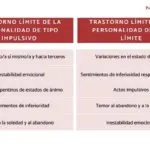
Personality disorders appear when the person’s way of being, thinking and feeling deviates from normality, altering their daily functioning, causing discomfort and preventing them from adapting to everyday situations in life (socially, professionally, etc.). staff,…).
Today we will learn about a very specific disorder, emotional instability personality disorder characterized by a marked impulsivity along with an unstable and capricious mood.
The disorder in ICD-10 and DSM-5
Emotional personality instability disorder It is a disorder included in the ICD-10, but not in the DSM-5 (Diagnostic and Statistical Manual of Mental Disorders). The ICD-10 classification for personality disorders, compared to that of the DSM-5, is more complex and structured.
The ICD-10 (International Classification of Diseases) groups personality disorders into different categories:
Defines Emotional Personality Disorder as the existence of a marked predisposition to act impulsively without taking into account the consequences, along with an unstable and capricious mood.
In this pattern of behavior, the planning capacity is minimal and the appearance of intense outbursts of anger is frequent, which lead to violent attitudes or explosive demonstrations; These are easily caused by receiving criticism or by the subject being frustrated by his impulsive actions.
There are two variants of this personality disorder, which share the general aspects of impulsivity and lack of self-control. They are the following.
Impulsive type emotional instability personality disorder
This characterized by emotional instability and lack of impulse control In addition, outbursts of violence or threatening behavior frequently appear, especially in the face of criticism from third parties.
It includes Explosive and Aggressive Personality and Explosive and Aggressive Personality Disorder for its diagnosis, and excludes Dissocial Personality Disorder for its diagnosis.
Borderline-type emotional instability personality disorder
Characteristics of emotional instability appear in him, and also distortions of body image, one’s own goals and intimate image (which are presented in a confusing or altered way).
There is also a feeling of emptiness and the ease of becoming involved in intense and unstable interpersonal relationships, which can generate repeated emotional crises and be accompanied by a succession of suicidal threats or self-harming acts. Self-destructive acts can also occur without clear precipitating factors. Thus appears a tendency to self-harm
It includes borderline personality and borderline personality disorder for its diagnosis.
In the DSM-5, ICD-10 Borderline Emotional Personality Disorder corresponds to Borderline Personality Disorder (BPD).
Treatment of impulsivity and impulse control
Let’s see how these two personality disorders can be treated in the clinical setting.
Focusing on the first subtype, impulsive-type emotional instability personality disorder, we can differentiate two areas to treat: impulsivity and impulse control.
For impulsivity, they have been proposed training techniques in self-instructions and problem solving (although the former are more focused on children and adolescents, they can also be used on adults).
Self-instruction training is a technique through which the subject gives himself a set of orders or instructions for the autonomous regulation of his own behavior.
The objective is to provide the child or adolescent a quick and effective way of acting to achieve success in a task or behavior preventing you from acting impulsively.
The problem-solving technique, for its part, has the objective of solve problems through well-defined steps and with the division of the problem into small parts.
For impulse control, at a psychological and behavioral level, you can use exposure techniques with response prevention (for example for pathological gambling associated with such a personality disorder), together with cognitive therapy.
At a pharmacological level, the following can be used to control impulses: neuroleptics, antidepressants, lithium and antiepileptics, among others.
Treatment of borderline personality disorder
The therapy that has been shown to be most effective to date for borderline personality disorder is dialectical behavioral therapy, developed by psychiatrist Marsha Linehan in the late 1990s.
The therapy presents BPD as an emotional dysregulation disorder. It follows an integrative approach, and is based on behavioral and cognitive principles along with elements of Mindfulness.
It is suitable for cases of BPD where suicide attempts have occurred; It also treats the symptoms of depression, anxiety, anger, impulsivity and impulse control, typical of the disorder. It is made up of 3 fundamental strategies: change, acceptance and dialectical understanding. The 4 treatment modalities are: individual therapy, telephone contact, therapist consultation, and group skills training.








